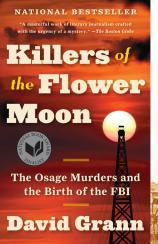Killers of the Flower Moon: The Osage Murders and the Birth of the FBI
Review
Killers of the Flower Moon: The Osage Murders and the Birth of the FBI
David Grann, the author of 2009’s much-lauded THE LOST CITY OF Z, brings new light to old evils in KILLERS OF THE FLOWER MOON. His latest work of narrative nonfiction examines one of the darkest chapters in United States history: the Prohibition-era “Reign of Terror,” a systematic slaying of the Osage people for their oil royalty headrights. His writing on the topic is succinct yet artful; one would expect no less of a staff writer at The New Yorker. However, the book’s true triumph is Grann’s thorough, earnestly compelling exploration of a labyrinthine conspiracy glossed over by a uniquely American case of historical amnesia.
In 1870, under threat of duress, the Osage had sold their lands in Kansas to settlers and purchased new territory in what is now known as Osage County, Oklahoma. It was a rocky and rather desolate place, but the neverending flow of white settlers soon pushed into this land as well. The Osage were forced to contend once more with manifest destiny, which culminated in the federal government’s mandate for allotment of reservation “real estate.” To protect themselves from being cheated, Osage leaders successfully negotiated with government officials to partition their land exclusively among members of the tribe, as well as give them full ownership of the mineral rights. When prospectors came out to drill for oil, they leased plots of land from the tribe, and the enormous oil reservoirs these plots were found to be sitting on top of led to the Osage becoming very, very rich.
"[T]he book’s true triumph is Grann’s thorough, earnestly compelling exploration of a labyrinthine conspiracy glossed over by a uniquely American case of historical amnesia."
True to form, the United States government couldn’t bear to have a people it disenfranchised become some of the wealthiest in the nation, so in 1921, Congress passed a law requiring each Osage to have a court-appointed white guardian oversee their fortune. Most of these guardians were prominent local figures like politicians and businessmen, while some were the white spouses of tribe members. The latter was the case of Mollie Burkhart, an Osage woman whose narrative is central to KILLERS OF THE FLOWER MOON. She lost all three of her sisters and their elderly mother to the Reign of Terror, along with countless other friends and acquaintances. These murder cases were neglected by local law enforcement officials who were either poorly trained, racist, corrupt, or some combination of the three.
Yet rather than flee the county, as so many other Osage had done, Mollie hired private investigators. When they failed, the tribe turned to the federal government for help. A fledgling agency then known as the Bureau of Investigations and its young director, J. Edgar Hoover, who was determined to carve out a place for his department as well as make a name for himself, stepped up to investigate the crimes against the Osage. The treachery they uncovered was shocking --- official estimates put the death toll at nearly 60 people --- but that would hardly be the end of this sordid story.
One of the most effective aspects of KILLERS OF THE FLOWER MOON is how Grann writes about his own research for the book. In “Chronicle Three: The Reporter,” which occupies little more than an eighth of the text’s entirety, he allows the reader to accompany him on his journey to Osage County, where he interviews historians and descendants of those who lived during the Reign of Terror. This final section of the book unpacks the Osage murders, revealing in this decades-old, sensational true crime story an indicator of what is and has always been wrong with America.
Reviewed by Alex Bowditch on April 19, 2017
Killers of the Flower Moon: The Osage Murders and the Birth of the FBI
- Publication Date: April 3, 2018
- Genres: History, Nonfiction, True Crime
- Paperback: 400 pages
- Publisher: Vintage
- ISBN-10: 0307742482
- ISBN-13: 9780307742483





